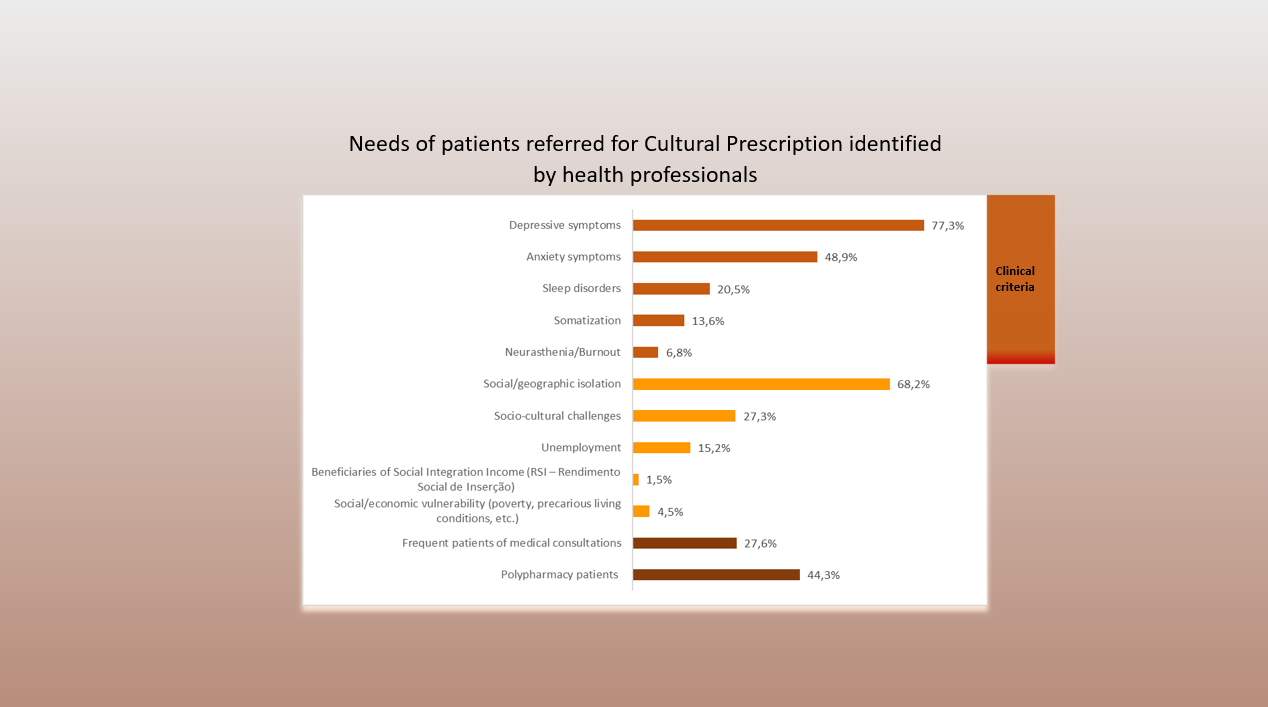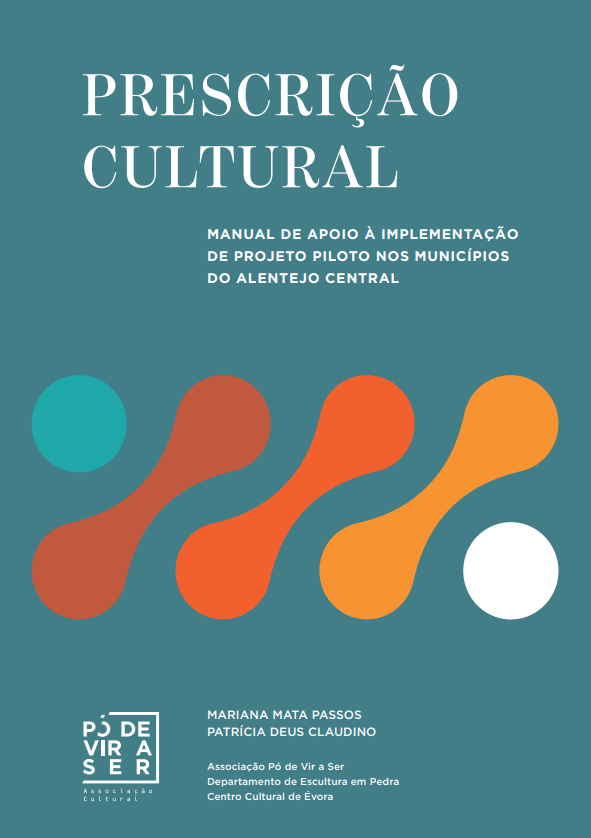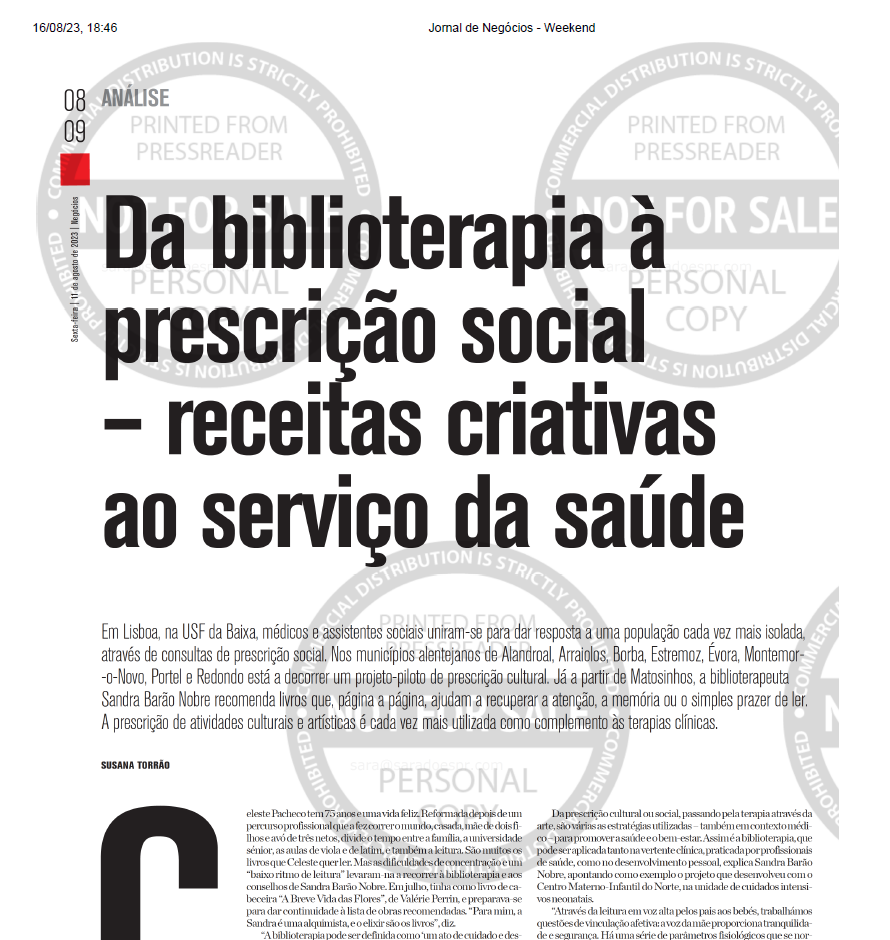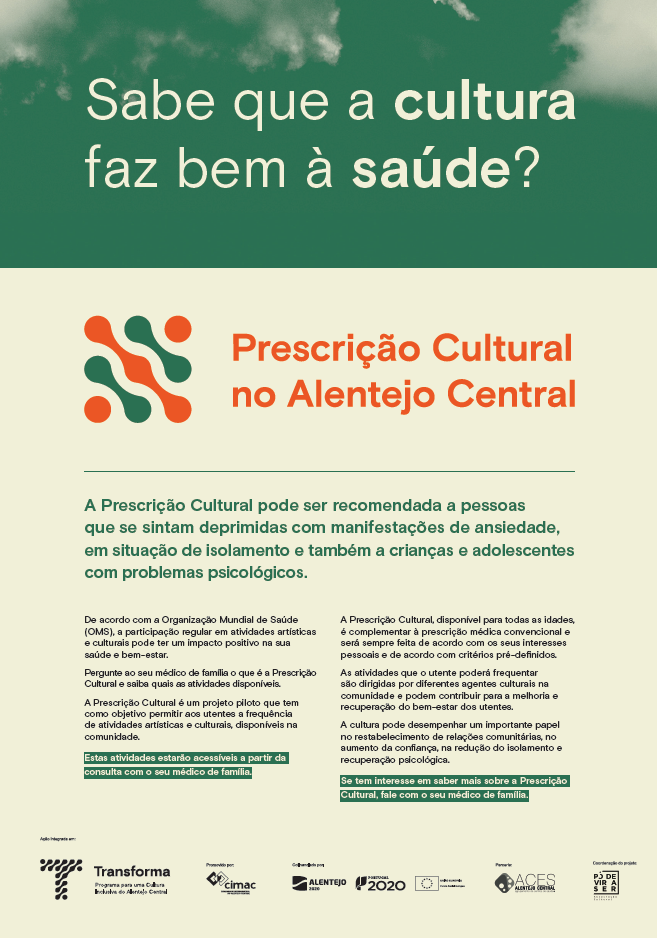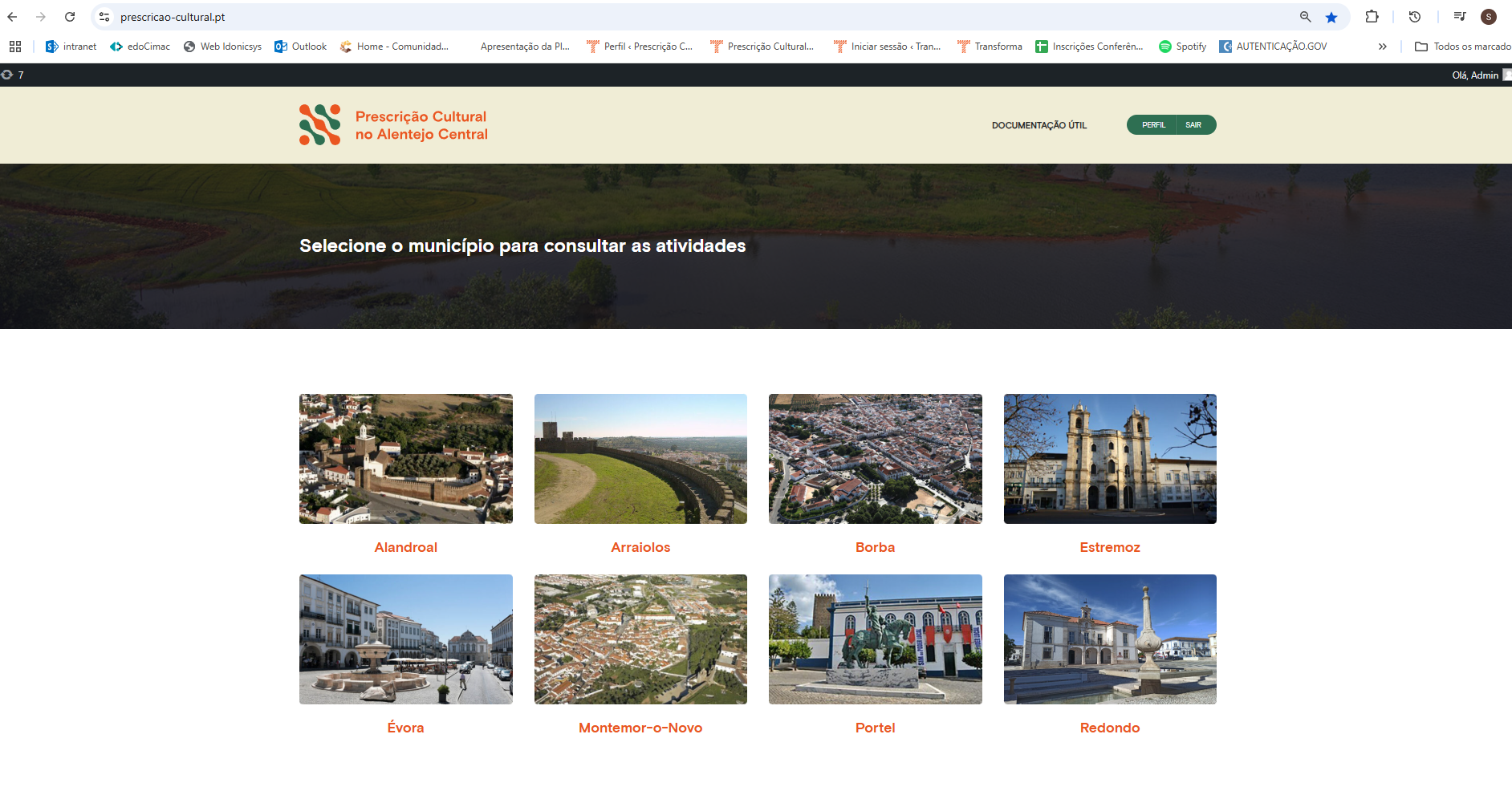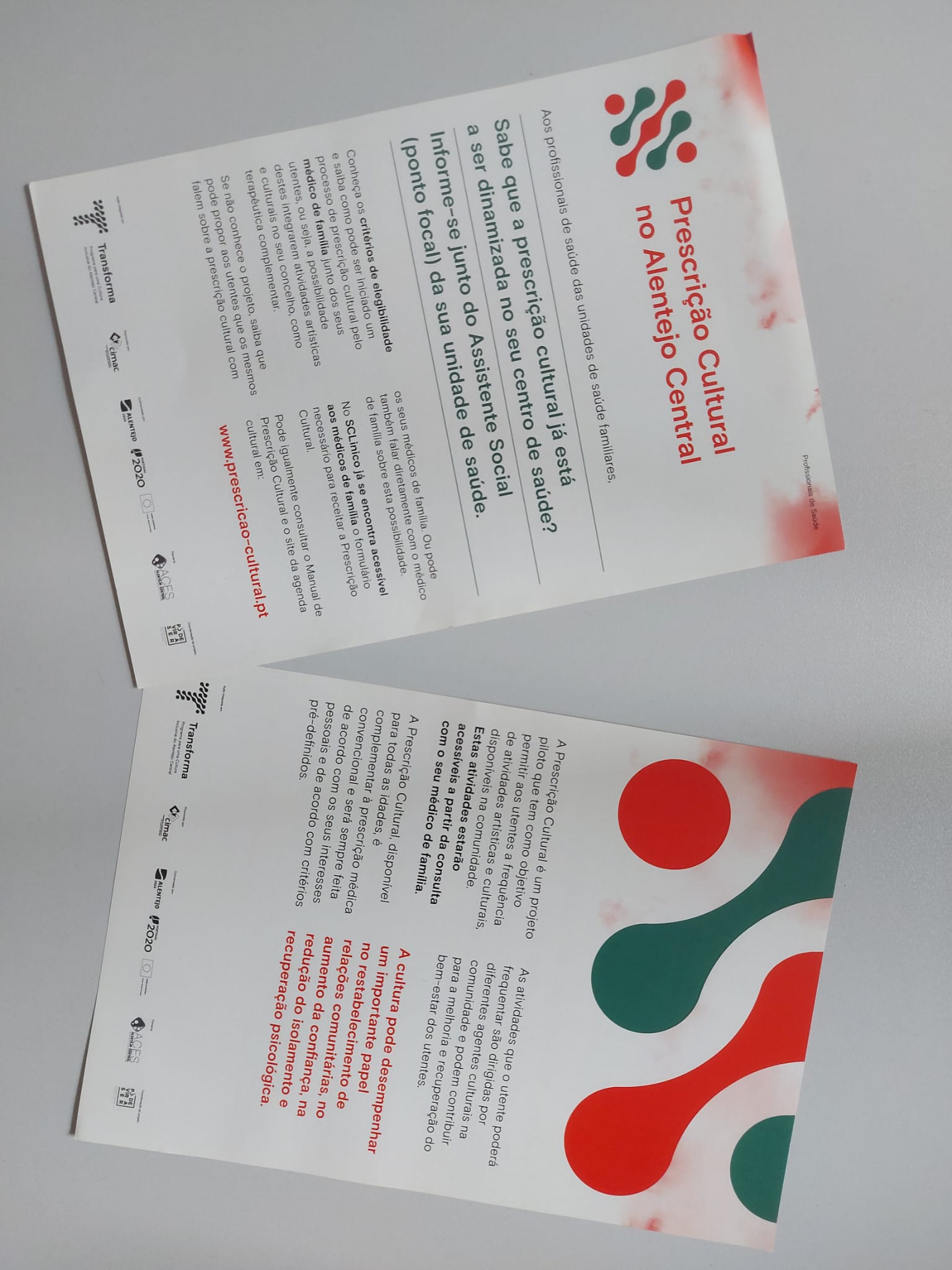Prioritising the places and people that need it the most
Cultural Prescription
Cultural Prescription in Central Alentejo
The Cultural Prescription project in Central Alentejo was a pilot project promoted by the Intermunicipal Community of Central Alentejo which followed the principle that culture and creativity has a transformative power, assuming those as essential elements in the promotion of mental health and well-being of citizens. It involves the prescription of cultural and creative activities by family doctors (GP) to users with mild to moderate mental health conditions.
Portugal
Local
It took place in eight municipalities from NUTII Alentejo Central, namely: Alandroal, Arraiolos, Borba, Estremoz, Évora, Montemor-o-Novo, Portel and Redondo.
It addresses urban-rural linkages
It refers to other types of transformations (soft investment)
Yes
2024-06-30
Yes
ESF : European Social Fund
No
No
As a representative of an organisation
The Cultural Prescription in Central Alentejo was a pilot project promoted by the Intermunicipal Community of Central Alentejo and co-financed by the ESF - Alentejo 2020. It began in 2021 with a diagnosis and a definition of an Implementation Model, and in 2023-24 the pilot implementation phase took place in 8 municipalities in Alentejo Central.
The project follows the principle that culture and creativity has a transformative power, assuming those as essential elements in the promotion of mental health and well-being of citizens. It involves the prescription of cultural and creative activities by family doctors (GP) to users with mild to moderate mental health conditions (depression, anxiety, burnout, sleep disorders). In addition to these, other social vulnerability factors are considered. The process implied that, through a rigorous circuit, the patient participates in the choice of the activity best suited to their interests and is accompanied throughout the process by a link worker and the healthcare system.
The target groups are people of all ages with the clinical eligibility criteria mentioned above, living in the 8 municipalities.
Interventions based on creativity, as a complement to traditional treatments; enhancing the holistic well-being of people with mental health problems; creating functional networks between health services, local authorities and the cultural fabric; mobilise existing community resources to promote the health and well-being of the most vulnerable, are some of the project's more specific objectives.
Over the course of the pilot, 88 prescriptions were made, of which 27 completed the prescription plan. In these, improvements were evident both in quality of life (improvement of depressive and anxiety symptoms) and in their involvement and participation, boosting their integration and social inclusion in the community.
The project is a candidate for the category ‘Prioritising the places and people that need it most’, in strand A.
The project follows the principle that culture and creativity has a transformative power, assuming those as essential elements in the promotion of mental health and well-being of citizens. It involves the prescription of cultural and creative activities by family doctors (GP) to users with mild to moderate mental health conditions (depression, anxiety, burnout, sleep disorders). In addition to these, other social vulnerability factors are considered. The process implied that, through a rigorous circuit, the patient participates in the choice of the activity best suited to their interests and is accompanied throughout the process by a link worker and the healthcare system.
The target groups are people of all ages with the clinical eligibility criteria mentioned above, living in the 8 municipalities.
Interventions based on creativity, as a complement to traditional treatments; enhancing the holistic well-being of people with mental health problems; creating functional networks between health services, local authorities and the cultural fabric; mobilise existing community resources to promote the health and well-being of the most vulnerable, are some of the project's more specific objectives.
Over the course of the pilot, 88 prescriptions were made, of which 27 completed the prescription plan. In these, improvements were evident both in quality of life (improvement of depressive and anxiety symptoms) and in their involvement and participation, boosting their integration and social inclusion in the community.
The project is a candidate for the category ‘Prioritising the places and people that need it most’, in strand A.
Mental Health
Arts
Communities
Inclusion
Interdisciplinarity
Although the project's objectives do not focus directly on environmental sustainability, they are developed with the intention of supporting the resilience and well-being of communities.In contributing to personal and community development, the cultural prescription also fits in with the sustainability value of the NEB. In the dynamics of developing cultural and artistic activities with and in the communities, through the cultural fabric involved, the project allowed spaces for active participation, where science and art came together to create healthier communities, more integrated in building a sustainable, inclusive and beautiful future for our minds and souls. When the GP prescribed culture, he valued human sustainability, experimenting new methods that have proven to be effective in similar contexts and can be replicable. He recognised the importance of creating complements to strict medication, of focusing on the person's interests improving their psychological condition and finding a reconnection with the community; this become possible through arts and their transformative power. One of the main objectives of the project in the target groups identified is to reduce the medication component in the medium and long term, because the user has found an alternative and reorientation of their mental health state in the routine of activity, social interaction and creative stimulation. In a broad sense, this reduction in chemical dependency in the recovery of users with mental illness can contribute to the existence of more autonomous, self-sufficient communities,more concerned with common environmental values and freer from value chains that they don't control. It is in this context of experimentation, of enabling replication in similar contexts, of contributing to the promotion and preservation of local culture, making it more accessible, innovative and sustainable, in defending healthier, more critical and more supportive communities, the project can be exemplary.
The main objectives of this project were to bring about greater individual enrichment for people, through the practice of meaningful creative activities, and to open doors to improving their general well-being by new approaches. The project shows its exemplarity in serving as a starting point for people to find a more balanced routine and personal growth through new learnings and new affections, to break the social isolation characteristic of mental illness and even to encourage job-seeking, thus contributing to helping them become more balanced and functional. The example of a child who chose to learn to play a musical instrument (an activity she has been doing for over a year), and who showed obvious improvements in her posture, motivation and well-being, demonstrating the importance that the Cultural Prescription had in overcoming a complex situation in her context of health and psychological well-being, allows us to gauge the quality of her experience; just as one participant's social isolation and mild depression were dispelled by her regular participation in the theatre group run by the municipality, and where she still continues to attend, is also an example of how the project improves people's lives -and communities- in the long term. There is also a connection to the qualities of the Central Alentejo territory, through the frequency of more traditional creative activities, such as the clay-making activity in Estremoz,a municipality where the traditional clay figurines of this place are classified as UNESCO material heritage, and where the demand from the participants for this activity was very high, reflecting their emotional and affective ties to the territory where they live. There is a clear emotional benefit in all the experiences, but also a cultural one: a sense of belonging to a group is generated, and the contribution of the cultural sector is a way of (re)connecting with the community, given that a significant part of the activities are collective.
The main results of this project highlight the added value of this holistic health approach, and is an example on how it can be an effective resource for managing the population's mental health, based on a community process that is interconnected. Portugal is the 5th country in the European Union with the highest prevalence of mental illnesses (depression, anxiety) and the first in the OECD in the consumption of anxiolytics.It is therefore important to promote more integrated care, linking the health area to local public policies and mobilising the community in general and the cultural fabric in particular to pay attention to the most vulnerable people. It is within this shared responsibility that we aim to promote social inclusion and the mental health of communities. The project promoted generalised access to cultural and creative activities for users with mental illness; raised awareness in the community on the problems of mental illness; raised awareness among health professionals on the importance of cultural and creative activities in patients' recovery: in addition to creative and cognitive advantages, they also help to create routines, bonds, affection, self-esteem and confidence, which are essential for boosting other behaviours and well-being.The project ensured that activities were free of charge for users; in the future, it is hoped that each municipality will be able to create a fund for cultural prescription and, more ambitiously, that the SNS will be able to co-pay for cultural activities, just as it does for medicines. In the evaluation report, you can find the proposal to include Cultural Prescription as a measure in the Local Social Development Plans and in Local and Regional Health Plans.Participation in cultural activities showed improvements both in people's quality of life (namely in the improvement of depressive and anxiety symptoms) and in their involvement and participation, boosting their integration and social inclusion in the community.
This project involved around 134 professionals. The health sector involved around 103 family doctors (including internists), 7 social workers and 2 computer engineers. From the cultural fabric, 54 cultural agents (with 34 available activities) were involved. CIMAC hired the Pó de Vir a Ser Cultural Association (3 members) and 1 Clinical Psychologist to help designing and implementing the project. It also established an evaluation protocol with the team from the National School of Public Health at University Nova de Lisboa (6 members). Of the 8 municipalities involved, 9 link workers were appointed; 3 technicians from CIMAC's culture division were involved in the entire process. It was thus a concerted participation with a demanding degree of complexity in its construction, but one that led to an initial very positive impact on the results evaluated, i.e. improving the health and well-being of users, or the community in general.
With an approach that seeks to make the user an active participant in the construction of their cultural prescription plan, it is essential that this plan is tailored to their needs, priorities and motivational profile. The process is supposed to be conducted and supported by evidence that the person chooses the activities and participation that make sense to them, empowering them in this personal decision-making process.
Through the participants' perspective, various motivations for taking part in the Cultural Prescription were identified. One of the main was the opportunity to socialise, given the participants' desire to meet new people and take part in group activities. This opportunity to socialise helped alleviate feelings of isolation, but also improved stress and anxiety levels. Participants reported improvements, particularly in their well-being, general outlook on life and communication skills. They felt more integrated into society, appreciating the emotional support from both professionals and colleagues.
With an approach that seeks to make the user an active participant in the construction of their cultural prescription plan, it is essential that this plan is tailored to their needs, priorities and motivational profile. The process is supposed to be conducted and supported by evidence that the person chooses the activities and participation that make sense to them, empowering them in this personal decision-making process.
Through the participants' perspective, various motivations for taking part in the Cultural Prescription were identified. One of the main was the opportunity to socialise, given the participants' desire to meet new people and take part in group activities. This opportunity to socialise helped alleviate feelings of isolation, but also improved stress and anxiety levels. Participants reported improvements, particularly in their well-being, general outlook on life and communication skills. They felt more integrated into society, appreciating the emotional support from both professionals and colleagues.
As inspiration, CIMAC reached out the experiences of UK and Denmark, by getting in touch with several entities and social scientists involved in Cultural Prescription experiences. The project’s first phase was assisted by the cultural association Pó de Vir a Ser and a clinical psychologist, who continued on the second phase. The reality of the 14 municipalities in Central Alentejo was mapped out, identifying existing local networks in order to gauge the possibility of experimentally implementing a cultural prescription circuit. A process of mediation was carried out between local agents in the areas of health, social action and culture, involving the Regional Health Authority and the different municipalities. Completed the first phase (construction of a methodology/manual and identification of networks of municipal organisers), it was concluded that conditions existed in only 8 municipalities. The regional health authority, an essential part of supporting the design of this project's circuit, was involved in its conception process, in a logic of a transdisciplinary approach. In the second phase, implementation begins with the family doctors at the health centres involved prescribing culture for patients who meet the eligibility criteria. Doctors have a key role as initiators of the process and are also the ones who have the most influence over the patients in accepting that arts and culture may improve their health. But the link workers (from municipalities) have an essential role to play: interviewing and deepening the patients interests, go with them to the first sessions of the chosen activities, following them during the time they take part in the activities, giving feedback to the designated focal points in the health centres, so that the report reaches the doctors.Also, the National School of Public Health was involved in the evaluation of the project's pilot phase. This School is the founder of the National Social Prescription Network, which CIMAC is part of.
This is an innovative project that integrates various disciplines and areas of knowledge, and is the result of collaboration between the health, cultural, social and academic sectors, mainly. In the Health sector, professionals involved (nurses, psychologists and social workers) can refer users with criteria to their family doctors, who are the prescribers of cultural activities. A clinical psychologist provides back-up support for the implementation of the whole process, and contributed to the design of the model and coordination of the project. She is accompanied by CIMAC's culture team, which includes two sociologists. In Culture, local artists and cultural agents develop and offer prescribed cultural activities; an attempt is made to meet the interests of the participants. In the Academia, higher education are involved, such as the National School of Public Health, contributing to the scientific evaluation of the project, guaranteeing the implementation of appropriate methodologies and the validation of the results obtained. Interaction between the various professionals is fundamental to the project's success. Communication between the health centre focal point and the link worker (who can be a social worker, a psychologist or a cultural technician, from the municipalities involved) is essential in the step following the prescription. It is also up to the link worker to liaise with the cultural agents and the participant, but also to maintain a channel of communication with CIMAC's administrative team and the clinical psychologist, who promote continuous adjustments and improvements.
This interdisciplinary approach allows for a more holistic response to the needs of the population, especially with regard to mental health and well-being. Integrating culture into medical prescriptions has demonstrated significant benefits, and also strengthens the link between the health and culture sectors, promoting a more comprehensive and inclusive vision of public policies.
This interdisciplinary approach allows for a more holistic response to the needs of the population, especially with regard to mental health and well-being. Integrating culture into medical prescriptions has demonstrated significant benefits, and also strengthens the link between the health and culture sectors, promoting a more comprehensive and inclusive vision of public policies.
The innovative nature of the project lies in the practical articulation between health services, municipal services and cultural scope of the region, in other words, between professionals from different areas of activity, with the common goal of leading citizens to a situation of improved health and well-being through the practice of cultural activities. It is innovative in methodology, in medical intervention, where the prescription of one or more cultural activities can complement the prescription of medication. It is in the multidisciplinary approach, at the intersection of health and culture, that this project innovates, and differs from the general practices. In Portugal, there are very few projects in this area, especially in the area of social prescribing, which is the umbrella for cultural prescribing, and is therefore still something new and very experimental. The follow-up given to the patient, after a medical consultation for a cultural prescription, by the link worker, who returns information on the patient's progress to the health services, also gives it an innovative and experimental dimension, and it should be emphasised that the results of the pilot allow us to gauge its feasibility and high degree of success. It is through this closeness that we ‘win’ the patient's motivation to take the first step and try something different, which could bring them well-being and improve their mental health in the long term.
A very important aspect that the project pursues is the valorisation of culture as a transformative element. For individuals and communities. And in this sense, the work done with the health sector was very important, as it risks on an unconventional methodology and recognised the rehabilitative factor associated to culture activities and creativity and their importance in improving everyone's mental health.
A very important aspect that the project pursues is the valorisation of culture as a transformative element. For individuals and communities. And in this sense, the work done with the health sector was very important, as it risks on an unconventional methodology and recognised the rehabilitative factor associated to culture activities and creativity and their importance in improving everyone's mental health.
The project is based on an approach in which the patient is an active participant in the construction of their cultural prescription plan, and it is essential that this plan is tailored to their needs, priorities and motivational profile, empowering them in this personal decision-making process.The 1st part of the project consisted in setting an implementation methodology,in which every step of Cultural Prescription process is described.In the 2nd phase, the circuit was implemented and a website (www.prescricao-cultural.pt) was created with all cultural activities available for prescription in the municipalities. All the issues regarding the data protection of users have been guaranteed, under the supervision of the Health Ethics Commission.As part of the project's monitoring and evaluation study, the methodology was based on 4 components:1)Analysing the sociodemographic profile, the needs identified according to the eligibility criteria and the trajectory of the patients referred; 2)Assessing the impact at patient level, namely on quality of life, well-being and mental health; 3)Assessing the implementation from the patients' perspective, including experience, positive aspects, challenges and suggestions for improvement; 4)Assessing the implementation from the perspective of the partners involved. The data was analysed using descriptive statistics. A quantitative study was carried out by administering self-completion questionnaires to participants. This assessment was carried out at 2 points in time: baseline (the moment of adherence to the project) and follow-up (10 weeks after the start of the activity or at the end of participation). 3 assessment scales were used:quality of life, using the Quality of Life Scale-EQ-5D-5L; Well-being using the Warwick-Edinburgh Mental Well-Being Scale-WEMWBS, and the Perception of Signs of Anxiety, Depression and Stress using the Anxiety, Depression and Stress Scale-EADS-21. Focus groups and interviews were also held.
This project has a high potential for transferability and replicability. Invitations have been sent to CIMAC to present the circuit, methodology and initial results in academic contexts, but also to organisations that work with groups and mental health issues. However, it is in the possibility of replication by other municipalities, not just in the Alentejo region, but throughout the country, that the greatest potential is envisaged. The project Manual defines the methodology, criteria and processes, how to involve partners (from health to culture, including municipalities and the community) and presents resources and strategies for implementing a cultural prescription model on the ground. It's a useful and accessible tool, with various bibliographical references, and creates the possibility of trialling the Central Alentejo model in similar contexts. The final Report of the pilot phase of the project also provides the results of an academic evaluation of the process, the perceptions of those involved in the process, the facilitators and obstacles encountered, and the impact on the well-being and health of patients, albeit still with discreet figures.
Other Intermunicipal Communities, like CIMAC, will be able to make use of this learning and model, having these two important documents available that summarise the phases of the project: from the methodology for building the cultural prescription circuit, to the way it is implemented and the initial results. This means that in other Health Centres and Municipalities, given that their operation and resources will have a similar structure, despite all the contingencies that may exist, the conditions for reproducing the project could effectively be found.
Other Intermunicipal Communities, like CIMAC, will be able to make use of this learning and model, having these two important documents available that summarise the phases of the project: from the methodology for building the cultural prescription circuit, to the way it is implemented and the initial results. This means that in other Health Centres and Municipalities, given that their operation and resources will have a similar structure, despite all the contingencies that may exist, the conditions for reproducing the project could effectively be found.
One of the project's major challenges is to finance cultural activities that are not free of charge, making it possible for all the prescribed participants to have access, regardless of their ability to pay. And this is a global challenge: how can the cultural agents involved in this type of project be paid? One of the solutions could be for municipalities to create a fund for Cultural Prescription, similar to other social support already granted to local residents. Another challenge facing the project is transport: for patients living in more isolated areas and far from the municipal centres - where there is more cultural activity - how do you create access for these people to the prescribed activities? Central Alentejo is a low-density area and the problem of transport is an old and relevant one, difficult to solve. Transport seems to be a global challenge in low-density areas; one of the solutions would be the political will to implement a ‘transport on demand’ system for the most isolated people, where municipalities would provide an alternative route to the existing public transport timetables, which are scarce. Along with transport, there is also a shortage of cultural resources in low-density councils, and one solution would be to invite local artists to design activities for the project, funded by the local authorities.But there are other challenges: collaboration between the health sector, municipalities and cultural agents in articulating and stabilising synergies is one of the main characteristics of this project, although it requires a considerable effort to create these synergies and achieve effective collaboration. Coordination between different sectors implies additional challenges, particularly building a basis of trust and proximity between the professionals involved. This liaison process requires a considerable investment of time, particularly through ongoing coordination to ensure that the sectors remain aligned and committed to implementation.
Given the category in which this application is presented, namely prioritising the places and people that need it most, and its inclusive (but also sustainable and transdisciplinary) nature, the results and impacts of the project reflect an example of good governance, developed between a range of local, regional and national partners.
Cultural Prescription has the potential to be a personalised health approach that integrates and makes visible the impact of social determinants of health on people's mental health. In this sense, the possibility of integrating and highlighting social determinants of health (such as social isolation, or socio-economic inequalities) as issues that require an intersectoral approach has allowed the professionals involved to rethink their intervention practices in the areas of health, but also social area. The integration of Cultural Prescription as a complementary approach to pharmacological intervention and as a social and creative intervention makes it possible to build a comprehensive support network in the community, boosting synergies between health professionals, municipal technicians and the cultural fabric, in the search for the best creative solutions to promote health and well-being in their communities. This benefits people in situations of greater vulnerability and social exclusion, promoting their inclusion in the community.
The main results of this pilot project and Cultural Prescription as a creative health approach highlight the value of a holistic approach to health. It promotes integrated care across different health areas, with the involvement of municipalities and incorporation of local cultural fabric. The involvement of local stakeholders in co-creating effective responses is crucial in this process. This shared responsibility approach encourages partnerships and synergies towards the development of a Cultural Prescription plan, providing a comprehensive and effective service to the population.
Cultural Prescription has the potential to be a personalised health approach that integrates and makes visible the impact of social determinants of health on people's mental health. In this sense, the possibility of integrating and highlighting social determinants of health (such as social isolation, or socio-economic inequalities) as issues that require an intersectoral approach has allowed the professionals involved to rethink their intervention practices in the areas of health, but also social area. The integration of Cultural Prescription as a complementary approach to pharmacological intervention and as a social and creative intervention makes it possible to build a comprehensive support network in the community, boosting synergies between health professionals, municipal technicians and the cultural fabric, in the search for the best creative solutions to promote health and well-being in their communities. This benefits people in situations of greater vulnerability and social exclusion, promoting their inclusion in the community.
The main results of this pilot project and Cultural Prescription as a creative health approach highlight the value of a holistic approach to health. It promotes integrated care across different health areas, with the involvement of municipalities and incorporation of local cultural fabric. The involvement of local stakeholders in co-creating effective responses is crucial in this process. This shared responsibility approach encourages partnerships and synergies towards the development of a Cultural Prescription plan, providing a comprehensive and effective service to the population.

